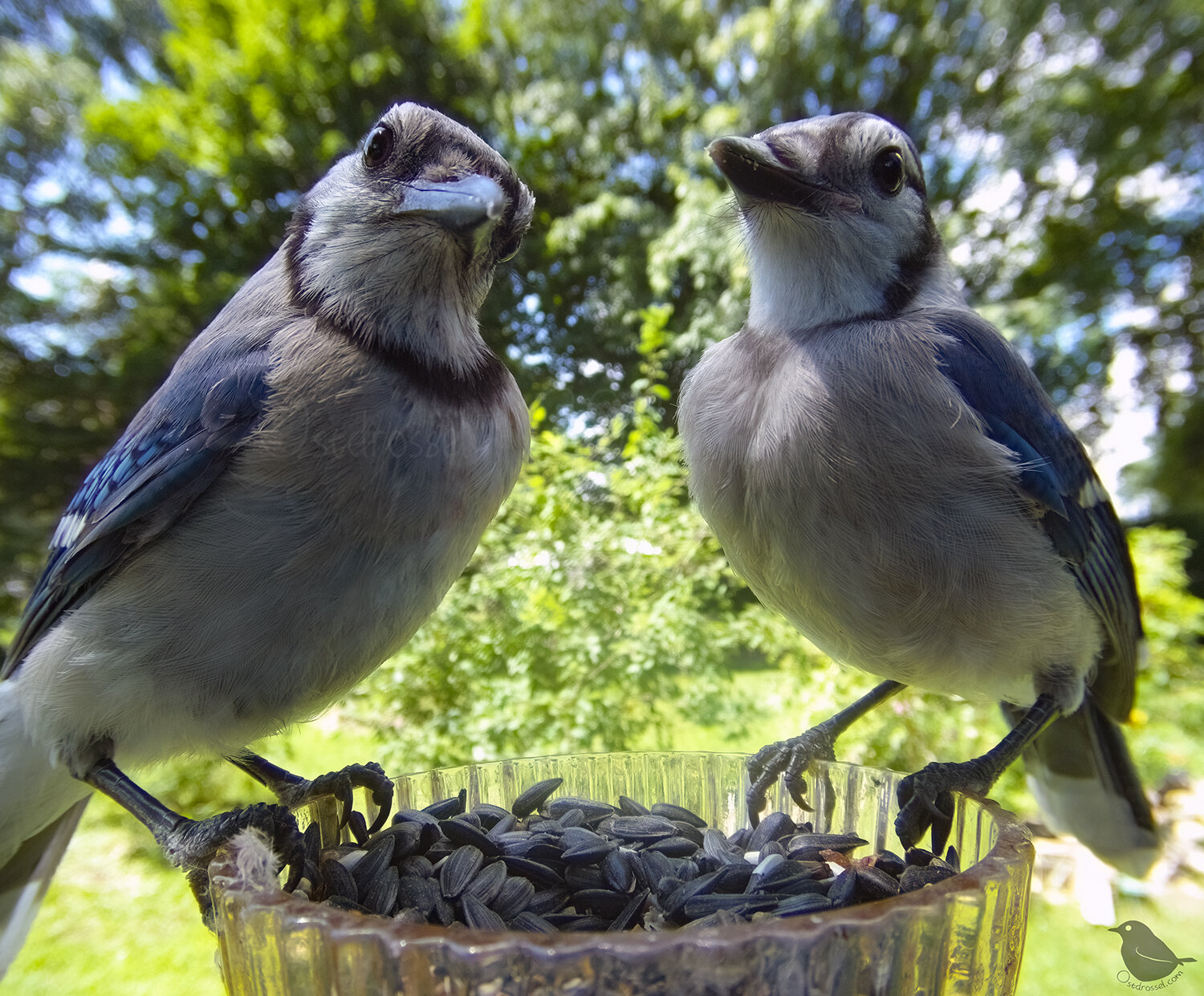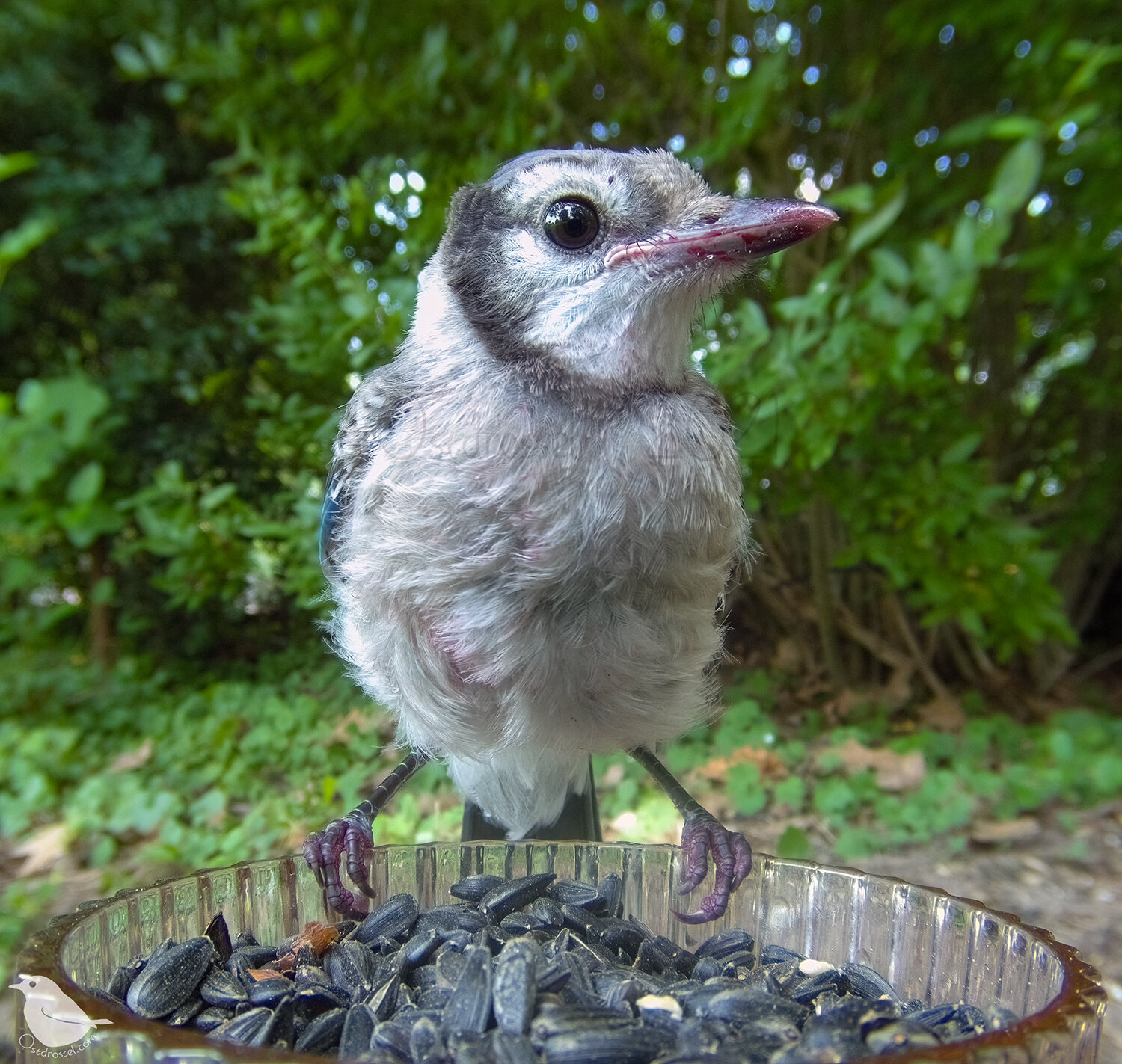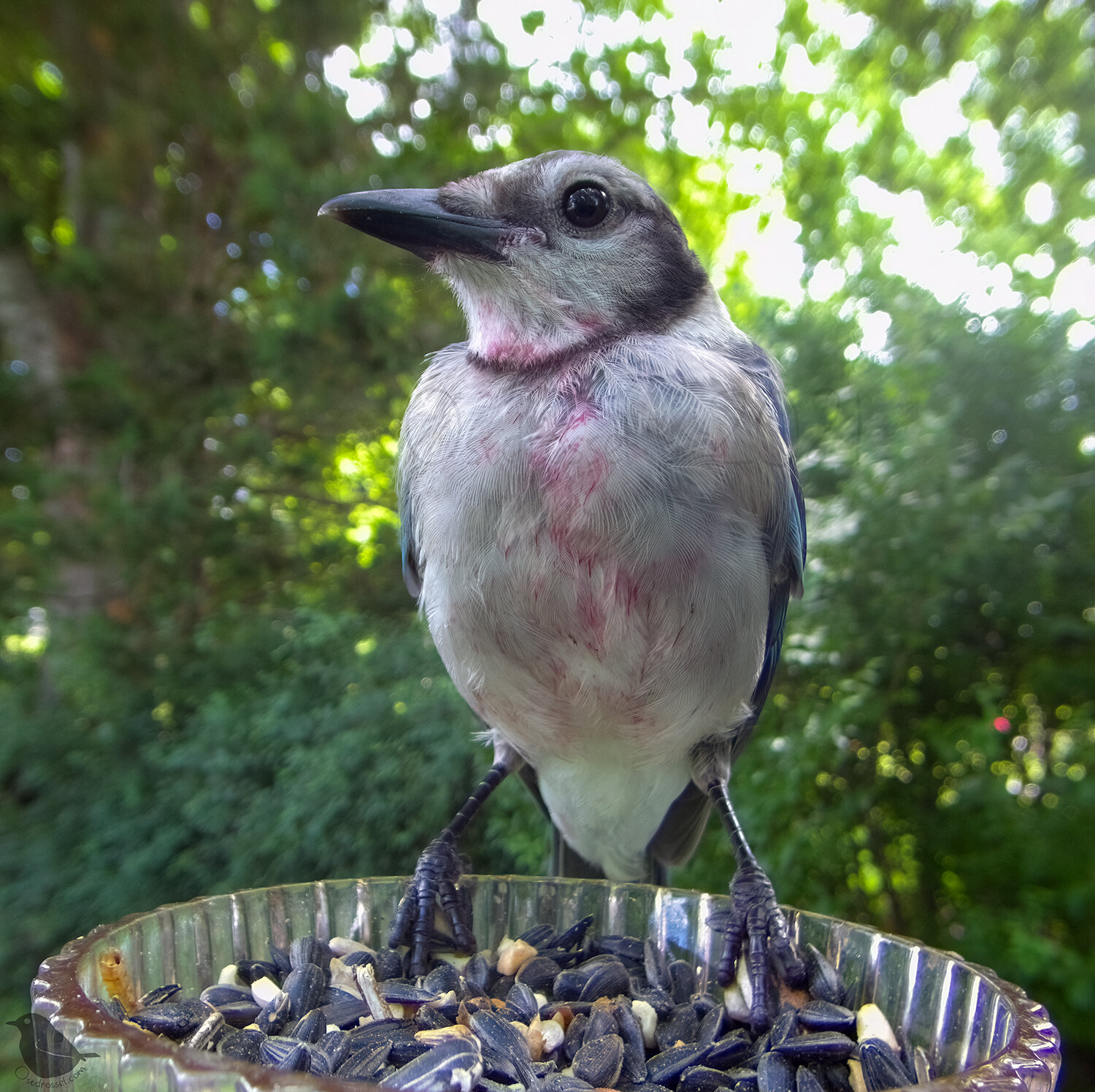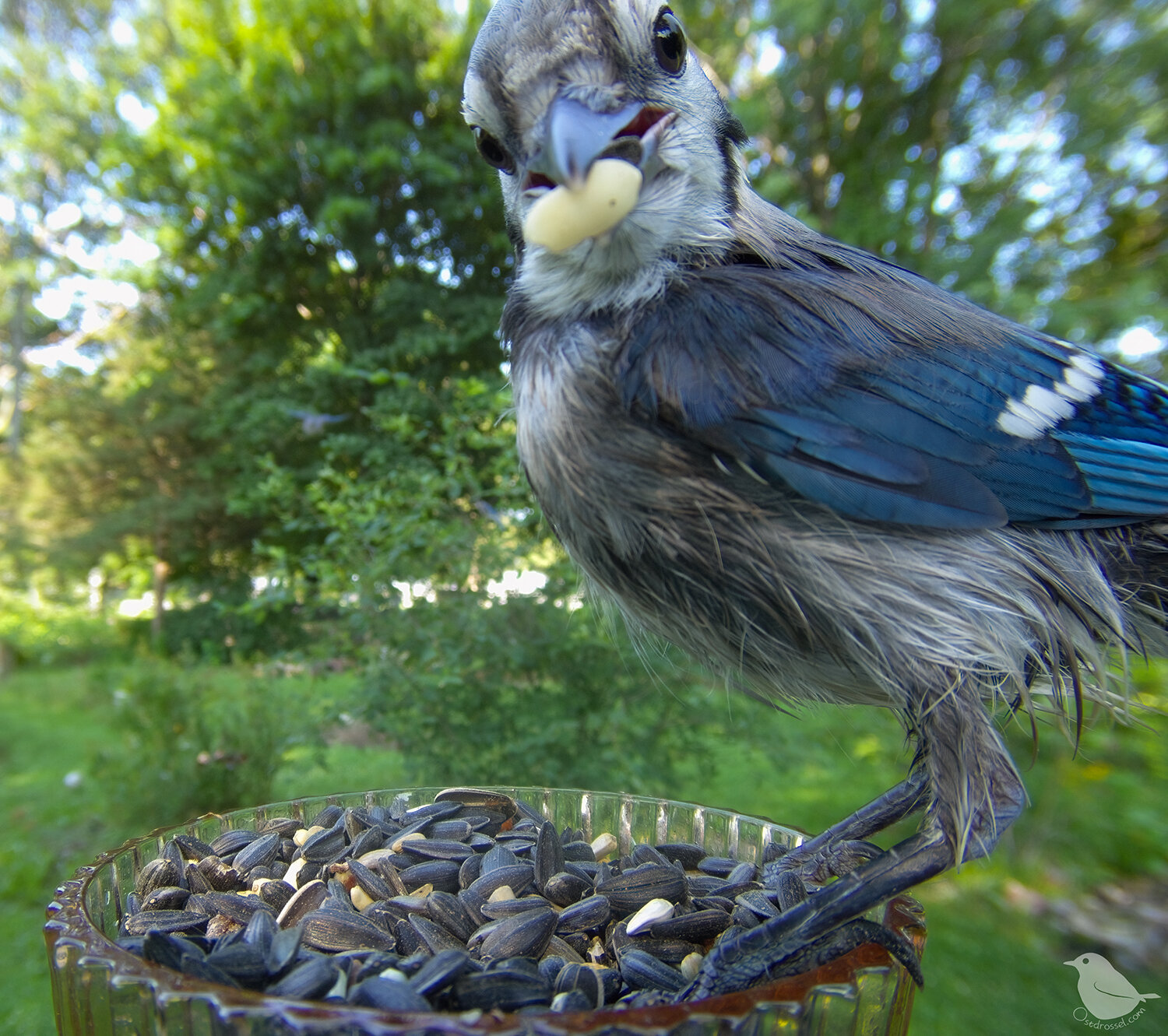Now is a good time
to learn more about sexual dimorphism in birds, the differences in the appearance of male and female birds. Often, the young ones look very similar to the females, which helps them staying safe / less visible when there is danger. Teenage birds can be hard to tell apart. Here is a Red-winged Blackbird, looking very much like the female, but if you look closely, you can see some reddish tones shooting in on the shoulders in the second photo, beginnings of the famous red epaulets of the males.
Common Grackles
are seemingly not everybody’s favorite due to their big appetite and sometimes overwhelming presence. I personally find them fascinating and love watching their interactions and behavior. And as with basically all animals, the young ones are particularly fun to watch. Some of the adults are still molting heavily while others are as shiny and gorgeous as in spring.
Last but not least...
A nut connoisseur 😆
(This is the Groundhog. I often get comments about what kind of fancy food the birds are getting here, so… I think the company that sells this mix buys stuff that fell to the ground in places that package nuts for human consumption, which is why sometimes there are more fancy nuts in there. I am a birder on a budget and would never buy snacky nuts to feed them to the birds or animals.)
Since there are plenty of them around
right now, here is another gallery of the blue screemers. Young and old, molting and not, individuals or groups. It feels like they are watching when I come out because as soon as I step away from a refill, they will be on the feeder. The babies are just so wonderfully goofy at that young age.
(Top row: adults, middle row: two young, a parent on the left and a baby on the right in the middle, baby, bottom row: all young ones (the photo in the middle captured Blue Jay spirit perfectly)
European Starlings
change their appearance quite a bit throughout the year and their life. The juveniles are starting to lose their brown baby feathers and growing into the speckled look that is their typical winter coat. The adults are losing their glossy breeding plumage, the yellow beaks of the males are turning dark again and their legs and feet become less vibrantly red. I always like this patchwork stage on them.
I am also seeing
more young MoDos now. And they all seem to have the squatter gene right from the start of their life! 😆😜
While summer is slowly
coming to an end, and I have not seen Grosbeaks for a couple of days now, I still have quite a few Baltimore Orioles around. It is mostly females and youngsters now, but there also still is the occasional male. They all either grow their first set of proper feathers or molt to get ready for migration. And they have to share the grape jelly with Robins, Woodpeckers and House Finches, too.
Along with the Titmice,
there have also been more Chickadees recently. They all raised babies and are starting to come back to the backyard again to delight with their appearance and songs. I always feel a little bad for them because they usually come to the camera when the bowl is empty. (Because then no other bird occupies it.) Nevertheless I am sure they still get their fill as I see them flitting around between feeders and trees a lot.
A MoDough.
Mourning Doves can be very dominating at the feeders, lifting their wings to shoo others away, pecking rivals away, or doing this. Just squatting down to digest and snack some more. I hope your Saturday is filled with lots of naps and good food as well.
Every evening,
when the sun starts going down and things calm down a bit, a Cardinal party starts. I have counted up to six adult individuals and several babies in the last few weeks. They are still pretty camera shy, but now that feeder traffic is getting a bit more normal, this beautiful female came to the bowl yesterday. It is my quest each year around this time to capture photos or video of the most adorable babies but so far I have not been very lucky.
Blue Jay babies
are all over the backyard right now, vocally as well as in numbers. I always find it interesting to see how individual birds differ in regards to markings or even age. In this little selection, there are some older ones as well as one that looks like it just stumbled out of the nest (the first one). As you can see, they also love mulberries.
The Red-winged Blackbird,
always ready to pop an artery 😆 There have been plenty of them this year, and they also seem to have had a really good bredding season. I see lots of babies all around the yard, and they also love the pond. Some of them are molting, but in their heads, they still look as impressive and gorgeous as ever 😊
This is my one side...
And this is my otter side. This Groundhog seems way too happy with himself 😆
Teenage birds
are all around right now. It is funny to see them explore because often, they are seemingly shy or timid but at the same time bold and unafraid. I love them all because I know they will only be here for a short time. Pictured: Redwinged Blackbird, Blue Jay, Oriole and Grackle.
More rain also means
more photos of wet Blue Jays! I hope you are not getting sick of seeing these because I still love them dearly. They are just so nice to study the patterns and structure of the plumage. And I just love the long faces too. I am still lagging a bit behind with processing photos but I am catching up, so there will be more possibly tonight or in the morning.
The hot phase of the summer
is here, the air gets stickier by the hour, and because of all the rain we have been getting, there are a lot of bugs around. I am happy for the birds but I am hesitant to spend a lot of time outside because I get eaten alive by the mosquitoes. The natural spray did not cut it this year, I have to get DEETed, but even that only helps for short periods. So I am happy that the cameras do all the work without me having to be present. Because there are some fun things happening. Like this Grack with a tonsure molt. There is one like that every year, and it always makes me giggle.
Nestbox update - House Wren
After no adult bird came to feed the Wren babies for almost 24 hours, we thought and pondered all day and then took them out the nestbox and brought them to a rehabber (Wild Wings in Hazel Park, they will be happy about donations, it is how they finance their good work). They were nine days old yesterday, not ready to fledge. The day before, the parent had fed them almost every 5 to 10 minutes, then suddenly nothing. The camera takes videos when there is motion or sound. It did not malfunction and I checked the clips as well as the livestream regularly to make sure. I did not want to see the babies die in the box, and I think waiting until the next morning would have sealed their destiny.
No adult bird has returned to the nestbox since. There are strong little birds and I hope they make it. Birds have a rough life, and unfortunately it happens that baby birds lose their parent/s too soon. The good thing is that there are licensed rehabbers who will take them in and care for them until they are ready to fledge.
I hope I get some updates. Be well, Wren babies ❤️
It is hard not to feel
with Dr. Clara, the resident Bluebird lady (even though she is a bird and has no human emotions). The whole family is around, and as you know, Mandrake comes to the nestbox several times a day, bringing stuff in or “forming the nest cup”. Yesterday, she was with him, and finally she also got into the box, checked things and formed the nest cup. And I am wondering if they are getting ready for maybe a last try this season. It is getting a bit late, though.
The baby Blue Jays
are all over the backyard now, exploring baths, feeders and plants. I absolutely adore these creatures with their curious and utterly cute faces and behavior. Some of them have been getting into the large Mulberry tree on the neighbor’s lot that is a huge bird magnet. If you wonder how to tell they are youngsters apart from the behavior - check out the pink edges of their beaks.






























































